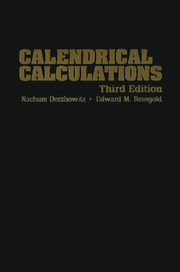Book contents
- Frontmatter
- Dedication
- Contents
- List of Frontispieces
- List of Figures
- List of Tables
- Abbreviations
- Mathematical Notations
- Preface
- Credits
- License and Limited Warranty and Remedy
- About the Cover
- 1 Calendar Basics
- I ARITHMETICAL CALENDARS
- II ASTRONOMICAL CALENDARS
- III APPENDICES
- A Function, Parameter, and Constant Types
- B Lisp Implementation
- C Sample Data
- Index
- Envoi
- About the Cover
B - Lisp Implementation
Published online by Cambridge University Press: 05 February 2014
- Frontmatter
- Dedication
- Contents
- List of Frontispieces
- List of Figures
- List of Tables
- Abbreviations
- Mathematical Notations
- Preface
- Credits
- License and Limited Warranty and Remedy
- About the Cover
- 1 Calendar Basics
- I ARITHMETICAL CALENDARS
- II ASTRONOMICAL CALENDARS
- III APPENDICES
- A Function, Parameter, and Constant Types
- B Lisp Implementation
- C Sample Data
- Index
- Envoi
- About the Cover
Summary
It has been often said that a person does not really understand something until he teaches it to someone else. Actually a person does not really understand something until he can teach it to a computer, i.e., express it as an algorithm.
—Donald E. Knuth: “Computer Science and its Relation to Mathematics,” American Mathematical Monthly (1974)This appendix contains the complete Common Lisp implementation of the calendar functions described in the text. The functions in the text were automatically typeset from the definitions in this appendix. These functions are available over the World Wide Web at
http://www.cambridge.org/us/9780521702386
Please bear in mind the limits of the License and that the copyright on this book includes the code. Also please keep in mind that if the result of any calculation is critical, it should be verified by independent means.
For licensing information about nonpersonal and other uses, contact the authors. The code is distributed in the hope that it may be useful but without any warranty as to the accuracy of its output and with liability limited to return of the price of this book, which restrictions are set forth on page xxviii.
Lisp Preliminaries
For readers unfamiliar with Lisp, this section provides the bare necessities. A complete description can be found in [1].
All functions in Lisp are written in prefix notation. If f is a defined function, then applies f to the n + 1 arguments e0, e1, e2, … en.
- Type
- Chapter
- Information
- Calendrical Calculations , pp. 361 - 440Publisher: Cambridge University PressPrint publication year: 2007

